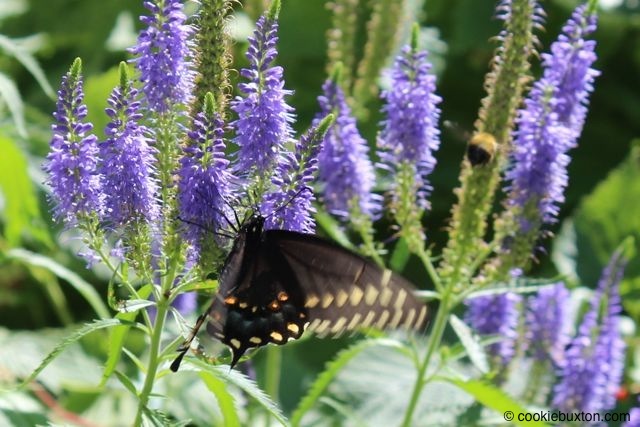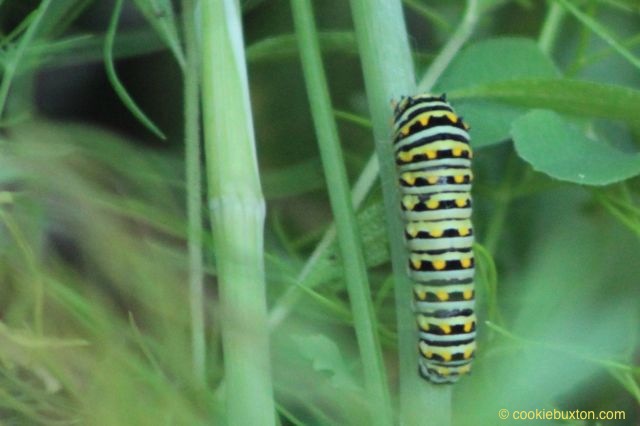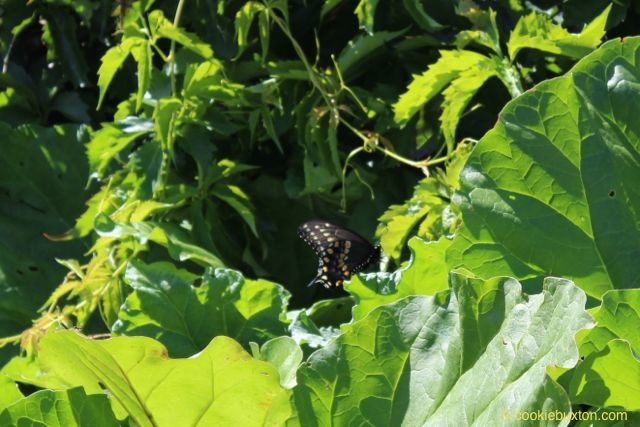Black Swallowtail Butterfly
Papilio polyxenes.
Black Swallowtail Butterfly.
My neighbour keeps a vegetable garden as well as a flower garden, and she loves growing dill, which is a popular host plant for caterpillar eggs. She lets the dill self-seed along a two-foot strip of garden that runs beside the boundary of her vegetable garden. One evening late in June, she invited me over to see some caterpillars that she had spotted in a thick patch of the dill growing behind her garage. She excitedly showed me where she had seen three of them, and as we hunted for these, we found several more.
We were guessing as to the type, but now, after a bit of research online, know them to have been black swallowtail caterpillars. I recently had the great pleasure of photographing an adult male as he flew between our two gardens and stopped to dine on nectar from several of his favourite plants, most particularly the Sunny Border Blue veronica that is widely planted throughout our two gardens.
In reading about the Black Swallowtail, and butterflies in general, I felt a great sadness to think that they have a lifespan, as a butterfly, of only 10 to 40 days. We all know the journey of the butterfly, and we pull the language of their extraordinary passage from caterpillar to art-on-the-wing into our everyday conversations and into the deeper language rhythms of poetry and literature.
I think that butterflies somehow transport us to places in our memories that we can barely recall. We see butterflies in our gardens, in the meadows, at the edge between forest and lake, along riverbeds and streams, and in our city parks. We are usually on foot, and probably the sun is shining warmly on our faces. If we are lucky, the swift dip and lift of a butterfly in flight will move across our range of vision and our eyes will start to track its pattern. It is a pattern we recognize and appreciate, and it is one that repeats throughout our lives. Many of us feel a sense of wonder, and, for that fleeting moment as we watch the butterfly, we are drawn into the natural world around us.
In terms of its range, the Black Swallowtail is found throughout Eastern Canada and into Manitoba, and south through to northern South America.
The colour markings on the Black Swallowtail’s large wings are memorable: the wing itself is black and has the swallowtail shape, and it features yellow checker-style markings along the edge of the wing; above that is a row of blue, and higher up, orange-to-yellow, markings. The female has a different colour pattern to the male. I will hopefully have an opportunity to photograph the female at some future time.
Each season, there are two to possibly three generations of the butterfly stage. The first butterflies appear in late May and June, the second in July through early August, and, weather permitting in our northern gardens, perhaps a third generation will appear in late summer.
If you are wanting to attract black swallowtail butterflies to your garden, consider planting the types of plants that offer them the right habitat as a host plant for the eggs and caterpillars, and for the mature adults: dill, a few carrots perhaps, and some Joe Pye Weed are among selections that offer the food and habitat they need.
Check online to obtain information on feeding and supporting butterfly populations in your area.
Photos & Text: NK
Garden: Home garden; neighbour’s garden (caterpillar)
Photo ID: 1307_31,1307_33, 1307_32
Copyright: www.cookiebuxton.com


